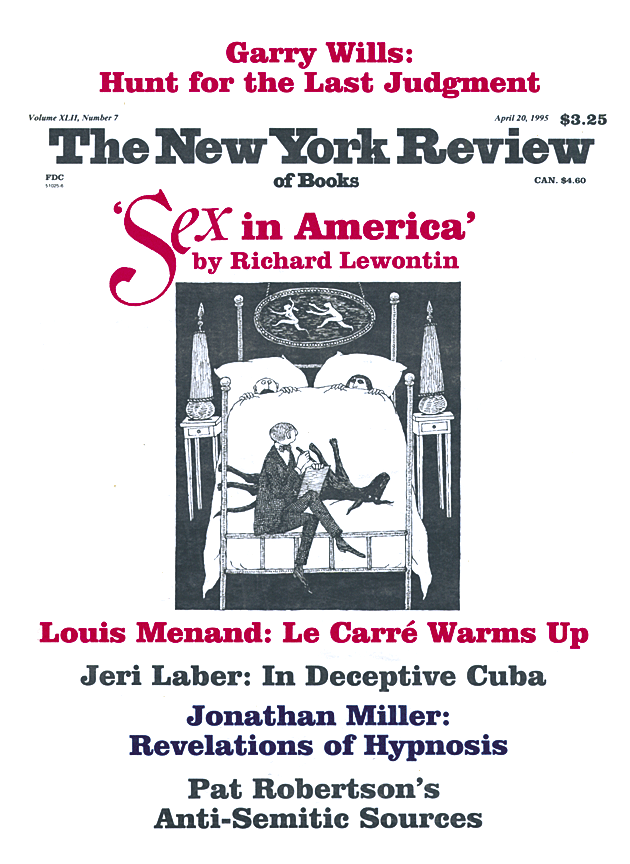In response to:
Good Sports & Bad from the March 2, 1995 issue
To the Editors:
In his review of recent examples of baseball’s “distinctive genre of biography for star players” [NYR, March 3], Stephen Jay Gould does not mention one of the early critics and satirists of the genre. Ring Lardner, from 1908 to 1913, spent “about ninety nights per annum in lower berths” traveling with the Chicago Cubs or White Sox (The New Yorker, November 1, 1930) and thus coming to know well some of the players and sports writers of that time.
In June 1913, Lardner began to conduct the Chicago Tribune’s daily sports column, “In the Wake of the News,” and he wasted no time in attacking the ghostwriting so prevalent in the early decades of this century. The following item appeared in the “Wake” for October 10, 1913:
First select a ball player who is a leader in his line—a star pitcher, a great batsman, a successful baserunner, a winning manager. Then peddle the stuff to as many papers as will take it. And then write it.
Writing it may seem the hardest part, but it isn’t. All you need is a typewriter, plenty of paper, and two or three old almanacs or joke books. The first article, a sort of introduction, is no cinch, because you are supposed to have a punch in it, something that will make the reader come back next day. The second and subsequent installments are easy. We could almost do them ourselves.
Actually, Lardner had already shown the ridiculousness of what Professor Gould describes in his review as “the conventions of the hagiographical mode—limitation of treatment to the heroic aspects of on-field play, told as an epic, so that the tragedies of defeat (borne with stoic honor) received equal space with the joys of victory.” In the “Wake” for September 28, 1913, the longest item was a piece titled “The First Game,” a narrative of that fall’s first World Series game between the Giants and Athletics, a game that was not really played until October 7, 1913. The narrator is an unnamed member of the Giants:
We ought to of trimmed ’em. When Egan, the big shot, said I was out at second he musta been full o’hops, the big boob. I like t’know where he was at las’ night, the big bum. Some o’ them umps oughta be on the chain gang, the big boobs.
Matty pitched wrong to Collins. That little bum couldn’t hit a curve ball with a mattress. Matty’s been pitchin’ long enough to know how to pitch, but sometimes he pitches like a damfool. I wisht he’d let me tell him somethin’. But d’ya think he’d listen to me? He knows it all. He oughta knew he didn’t have speed enough no more to get one past that guy.
Wisht Mac had let me wallop when I had the big Indian three and nothin’ that time. ‘Member? Merkle was on third base. I looked ’round and Mac gives me the sign to take one, That’s rotten baseball, I think. I took one that I could of hit out of o’ the park. Then the big Indian hooks one on me and I missed. Then I’m I lookin’ for another hook and he comes with a fast one. And the Catfish calls me out. That last one was a foot outside. If I’d a known he was goin’ to call it on me, I’d a hit that one out o’ the park. The big rum.
Those ninety nights per annum on the road and innumerable days at home had paid off. Lardner knew the players of his day, and he knew what an unghosted piece would truly sound like.
Lardner’s classic “autobiography” is, of course, the fictional You Know Me Al, in which the semi-literate Jack Keefe reveals himself in a letter to his friend Al as the very opposite of everything he believes himself to be: a sharp wisecracker, an unbeatable pitcher, an irresistible lover, and a model husband. The book is still the wisest and gentlest and funniest anti-hagiography ever written.
Howard Webb
Carbondale, Illinois
Stephen Jay Gould replies:
Webb’s excellent reminder of Ring Lardner’s wit and insight underscores the major point of my review—that the “distinctive genre of biography for star players” operated only in the hagiographical mode before our recent transition to the “kiss and tell” genre. Lardner did need to be truthful—so he wrote fiction, not biography. Ironically, the accepted conventions of supposedly factual biography relegated all truthful accounts to the cover of story-telling.
This Issue
April 20, 1995


